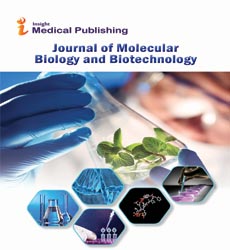Editorial: A Note on Stable Isotope Probing
Daniel Andrewsa*
Department of Molecular Biology, Harvard University, USA
- *Corresponding Author:
- Daniel Andrewsa
Department of Molecular Biology,
Harvard University,
USA,
E-mail: dan.andrews@monash.edu
Received Date: October 05, 2021; Accepted Date: October 19, 2021; Published Date: October 26, 2021
Citation: Andrewsa D (2021) Editorial: A Note on Stable Isotope Probing. J mol Biol Biotech. Vol. 6 No.5: e003.
Description
Stable-Isotope Probing (SIP) is a philosophy in microbial environment for following take-up of supplements in biogeochemical cycling by microorganisms. A substrate is advanced with a heavier stable isotope that is devoured by the living beings to be studied. Biomarkers with the more isotopes joined into them can be withdrawn from biomarkers containing the more normally plentiful lighter isotope by isopycnic centrifugation. For example, 13CO2 can be used to find which animals are adequately photosynthesizing or devouring new photosynthate. As the biomarker, DNA with 13C is then disengaged from DNA with 12C by centrifugation. Sequencing the DNA recognizes which life forms were burning-through existing starches and which were utilizing sugars all the more as of late delivered from photosynthesis. SIP with 18O-named water can be utilized to discover which organic entities are effectively developing, since oxygen from water is consolidated into DNA (and RNA) during synthesis.
Right when DNA is the biomarker, SIP can be performed using isotopically stamped C, H, O, or N, however 13C is utilized regularly. A more frail DNA light thickness shift is seen when 15N-versus 13C-named substrates were used in unadulterated culture. Alternately, an exceptionally solid light thickness shift was seen when the two names were used.
Working of SIP
In a regular SIP study, a 13C type of the impurity (e.g., 13Cbenzene) is adsorbed to a detached microbial testing gadget, for example, Bio-Sep globules inside a Bio-Trap sampler. Bio-Sep dots are a designed composite of Nomex and powdered initiated carbon (PAC). PAC adsorbs the 13C-marked compound and furthermore gives an enormous surface region to microbial colonization and development. Nomex permits the dots to be heat disinfected before the examination. A particularly aloof sampler is conveyed in a checking great.
During the sending time frame (30 to 90 days), the 13Cmarked pollutant is dependent upon similar microbial cycles as unlabeled impurity present at the site. Numerous pollutants, like petrol hydrocarbons, are utilized as a carbon and energy hotspot for microbial development. In this way, in case biodegradation is happening, impurity debasing microorganisms will colonize the Bio-Trap and utilize the 13C-named toxin as a carbon and energy hotspot for development and the 13C name will be joined into microbial biomass or 13CO2.
After sending, the Bio-Trap is recuperated for gas chromatography and isotope proportion mass spectrometry (IRMS) investigation to measure the 13C/12C proportion of biomass and broke down inorganic carbon. The 13C name will either be joined into microbial biomass or mineralized to 13CO2. Identification of 13C-enhanced biomolecules (phospholipids, DNA, or protein) and 13C-advanced broke down inorganic carbon (DIC) following arrangement unambiguously demonstrates that in situ biodegradation happened. On the other hand, in case biodegradation isn't happening, the 13C/12C proportion of the microbial biomass and DIC examined after in well sending will be like foundation esteems. Phospholipid unsaturated fats (PLFA) are a fundamental part of microbial cell layers, subsequently, 13C-improved PLFA unambiguously exhibits joining of the 13C into biomass. Moreover, 13Cadvanced disintegrated inorganic carbon (e.g., CO2, HCO3-) gives decisive proof of toxin mineralization
Advantages
Indisputable
SIP can give definitive proof that in situ biodegradation of the toxin is happening.
Comprehensively appropriate
A SIP study can be directed for any foreign substance that is utilized as a carbon and energy source, up to an isotopicallyadvanced type of the pollutant can be combined.
No earlier information required: No earlier information is required about the type(s) of microorganisms, biodegradation pathway(s), or quality successions.
Sensible expense
For some normal foreign substances like BTEX, MTBE, TBA, and even naphthalene, the expense to blend the 13Cmarked compound is sensible. For instance, the expense for a SIP concentrate with 13C benzene including the expense of orchestrating the 13C compound, postarrangement investigation, and revealing is ~ $1,000.
Limitations
Not material to all impurities: SIP is for the most part not suitable for intensifies that are utilized as terminal electron acceptors, like trichloroethylene (TCE) and other chlorinated ethenes, in light of the fact that the 13C name isn't fused into biomass or CO2 during this microbial interaction. Instruments, for example, compound-explicit isotope examination (CSIA) performed on the actual impurity is more material for these mixtures. For enormous or more intricate mixtures, union of the 13C-marked compound can be costly or essentially not accessible.
Weaken tufts
Data got from run of the mill SIP considers where centralizations of 13C-named compounds are generally high may not really extrapolate to biodegradation of the toxin present in a weaken crest where pollutant fixations are moving toward conclusion levels.
Open Access Journals
- Aquaculture & Veterinary Science
- Chemistry & Chemical Sciences
- Clinical Sciences
- Engineering
- General Science
- Genetics & Molecular Biology
- Health Care & Nursing
- Immunology & Microbiology
- Materials Science
- Mathematics & Physics
- Medical Sciences
- Neurology & Psychiatry
- Oncology & Cancer Science
- Pharmaceutical Sciences
